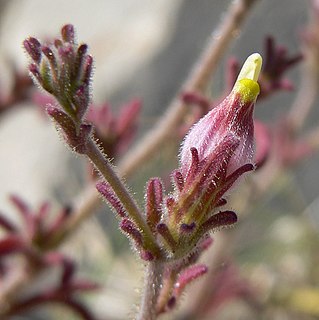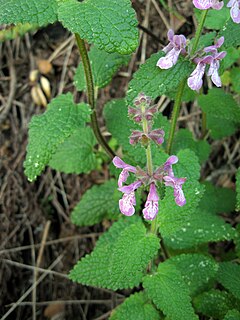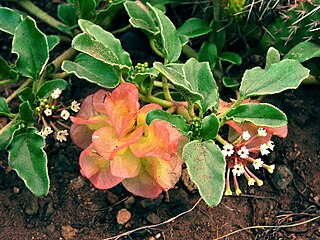Collinsia greenei is a species of flowering plant in the plantain family known by the common name Greene's blue-eyed Mary.

Cordylanthus parviflorus is a species of flowering plant in the family Orobanchaceae known by the common name purple bird's beak. It is native to the western United States where it grows in several types of habitat, including the sagebrush steppe of the Great Basin. It is an annual herb, red-tinted gray-green in color, and hairy, glandular, and sticky in texture. It grows 20 to 60 centimeters tall. The inflorescence bears flowers accompanied by hairy, lobed red-green bracts. The flower is up to 2 centimeters long, made up of a dark-veined pink pouch enveloped in darker sepals.

Epilobium siskiyouense is a rare species of flowering plant in the evening primrose family known by the common names Siskiyou willowherb and Siskiyou fireweed.

Hoita strobilina is a rare species of legume known by the common name Loma Prieta leatherroot, or Loma Prieta hoita. It is endemic to California, where it is known from occasional occurrences in the San Francisco Bay Area. It grows in chaparral and woodland habitat in the local mountains, often on serpentine soil. This is a perennial herb growing erect, approaching a meter in maximum height. The large leaves are divided into three leaflets each up to 8 centimeters long and lance-shaped to nearly round. The herbage is generally glandular and hairy. The inflorescence is a raceme up to 13 centimeters long containing many pealike flowers. Each flower is purple, sometimes with white parts, and one to two centimeters long. The fruit is a dark brown or black, hairy, veiny legume pod.

Nama rothrockii is a species of flowering plant in the borage family known by the common name Rothrock's fiddleleaf. It is native to the mountains and plateaus of eastern California, such as the southern Sierra Nevada, and western Nevada and Arizona, where it grows in several types of local habitat.

Navarretia pubescens is a species of flowering plant in the phlox family known by the common name downy pincushionplant.

Phacelia curvipes is a species of flowering plant in the borage family, Boraginaceae, known by the common names Washoe phacelia and Washoe scorpionweed. It is native to the southwestern United States, where it grows in many types of habitat, such as chaparral, oak and pine woodland, and forests.
Phacelia longipes is a species of phacelia known by the common name longstalk phacelia. It is endemic to California, where it grows in the Transverse Ranges and adjacent western Mojave Desert. Its habitat includes chaparral, woodland, and forest, in rocky soils.
Phacelia mustelina is an uncommon species of phacelia known by the common names weasel phacelia and Death Valley round-leaved phacelia. It is native to the desert mountains and flats of eastern California and western Nevada, where it grows in woodland and open scrub habitat.
Potentilla biennis is a species of cinquefoil known by the common names biennial cinquefoil and Greene's cinquefoil. It is native to western North America from northwestern Canada to the southwestern United States, where it grows in moist habitat. This is an annual or biennial herb producing an erect stem up to 70 centimeters tall from a taproot. It is hairy and glandular in texture. The hairy leaves are each divided into three toothed, oval leaflets each up to 3 centimeters long. The inflorescence is a cyme of several flowers. Each flower has five oval yellow petals 1 or 2 millimeters long and five triangular sepals which are slightly longer. The fruit is a minute whitish achene.

Ribes sericeum is a species of currant known by the common name Lucia gooseberry, or Santa Lucia gooseberry; its Latin epithet of sericeum means "of silk". It is endemic to California, where it is known only from the Santa Lucia Mountains along the Central Coast and an additional isolated population in Santa Barbara County.
Rupertia rigida is a species of flowering plant in the legume family known by the common name Parish's California tea, or Parish's rupertia.

Sagina apetala is a species of flowering plant in the family Caryophyllaceae known by the common names annual pearlwort and dwarf pearlwort. It is native to Europe and it is known elsewhere as an introduced species, including parts of North America. It grows in many types of disturbed habitat, such as cracks in the sidewalk. It is a petite annual herb producing a threadlike stem just a few centimeters long, spreading or growing erect. The plant is glandular and somewhat hairy. The leaves are linear in shape and not more than about a centimeter long. The inflorescence is a solitary flower borne on a threadlike pedicel. The flower has usually four sepals and generally no petals.

Silene bernardina is a species of flowering plant in the family Caryophyllaceae known by the common name Palmer's catchfly.

Spergularia villosa is a species of flowering plant in the family Caryophyllaceae known by the common name hairy sandspurry. It is native to southern South America, and it is known in the southwestern United States and Baja California as an introduced species and casual weed. It grows in a wide variety of habitat types. It is a small perennial herb producing a sprawling stem up to 30 centimeters long with a woody base. It is coated in glandular hairs. The leaves are generally linear in shape and measure a few centimeters long. They are accompanied by dull white lance-shaped stipules. The flowers have hairy, glandular sepals and five oval whitish petals.

Stachys bullata is a species of flowering plant in the mint family known by the common name California hedgenettle.

Stachys chamissonis is a species of flowering plant in the mint family known by the common name coastal hedgenettle. It is a perennial herb native to the west coast of North America, where it grows in moist coastal habitat from Alaska to central California. This mint produces an erect stem 1 to 2+1⁄2 meters. It is hairy, glandular, and aromatic. The oppositely arranged leaves have pointed, wavy-edged blades up to 18 centimeters (7.1 in) long which are borne on petioles. The hairy, glandular inflorescence is made up of interrupted clusters of up to six flowers each. The flower has a deep pink tubular corolla which can be over 3 centimeters (1.2 in) long. The corollas are borne in hairy calyces of purple or purple-tinged sepals.
Tripterocalyx crux-maltae is a species of flowering plant in the four o'clock family known by the common names Lassen sandverbena and Kellogg's sand-verbena.

Tripterocalyx micranthus is a species of flowering plant in the four o'clock family known by the common names smallflower sandverbena and small-flowered sand-verbena.

Conradina grandiflora is a species of flowering plant in the mint family known by the common name largeflower false rosemary, or large-flowered rosemary. It is endemic to Florida in the United States, where it occurs on the Atlantic coastal ridge. Its distribution spans Brevard, Broward, Dade, Highlands, Indian River, Martin, Osceola, Palm Beach, Polk, St. Lucie, and Volusia Counties.















